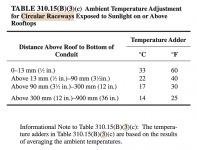310.15(B)(2)(a) is the table for temperature corrections. How do you determine the temperature for a conduit on a roof? I’m proposing the put a single emt conduit on 4x4’s Accross the roof to a junction box. The conduit would have 6 current carrying conductors and one grounding conductor. The loads are 3 air conditioner compressors. With minimum circuit ampacity of 42 amps, max breaker 45 amps. 240 volts 1 phase. I was using the 90* column of of 310.15(B)(2)(b). I have to derate for 9 conductors, so multiply by .70 per 310.15(B)(3)(a) them multiply by 310.15(B)(2)(a). How do you determine the temperature to use?
I found this website. Would that be correct, or is there another method? I’m in Chicago and using that table, I come up with #6 conductors for a 45 amp circuit. 75x.70x.82=43.05.
I found this website. Would that be correct, or is there another method? I’m in Chicago and using that table, I come up with #6 conductors for a 45 amp circuit. 75x.70x.82=43.05.



